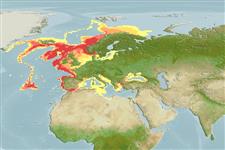Common names from other countries
Environment: milieu / climate zone / depth range / distribution range
Écologie
; profondeur 1 - 1829 m (Ref. 85345), usually 50 - 400 m (Ref. 125144). Subtropical; 72°N - 9°N, 19°W - 37°E
Distribution
Pays | Zones FAO | Écosystèmes | Occurrences | Introductions
Northeast Atlantic, Eastern Central Atlantic and the Mediterranean.
Length at first maturity / Taille / Poids / Âge
Maturity: Lm ? range ? - ? cm
Depth based on occurrence (Ref. 2851, p. 719); to be replaced with better reference.
Life cycle and mating behavior
Maturité | Reproduction | Frai | Œufs | Fécondité | Larves
Members of the class Asteroidea exhibit both asexual (regeneration and clonal) and sexual (gonochoric) means of reproduction. Life cycle: Embryos hatch into planktonic larvae and later metamorphose into pentamorous juveniles which develop into young sea stars with stubby arms.
Alves, F., L. Chicharo, A. Nogueira and J. Regala. 2003. (Ref. 2851)
Statut dans la liste rouge de l'IUCN (Ref. 130435: Version 2024-1)
statut CITES (Ref. 108899)
Not Evaluated
Not Evaluated
Utilisations par l'homme
| FishSource |
Outils
Plus d'informations
Taille/ÂgeCroissanceLongueur-poidsLongueur-longueurMorphologieLarvesAbondance
Sources Internet
Estimates based on models
Preferred temperature
(Ref.
115969): 1.7 - 10.5, mean 7.1 (based on 112 cells).
Catégorie de prix
Unknown.
